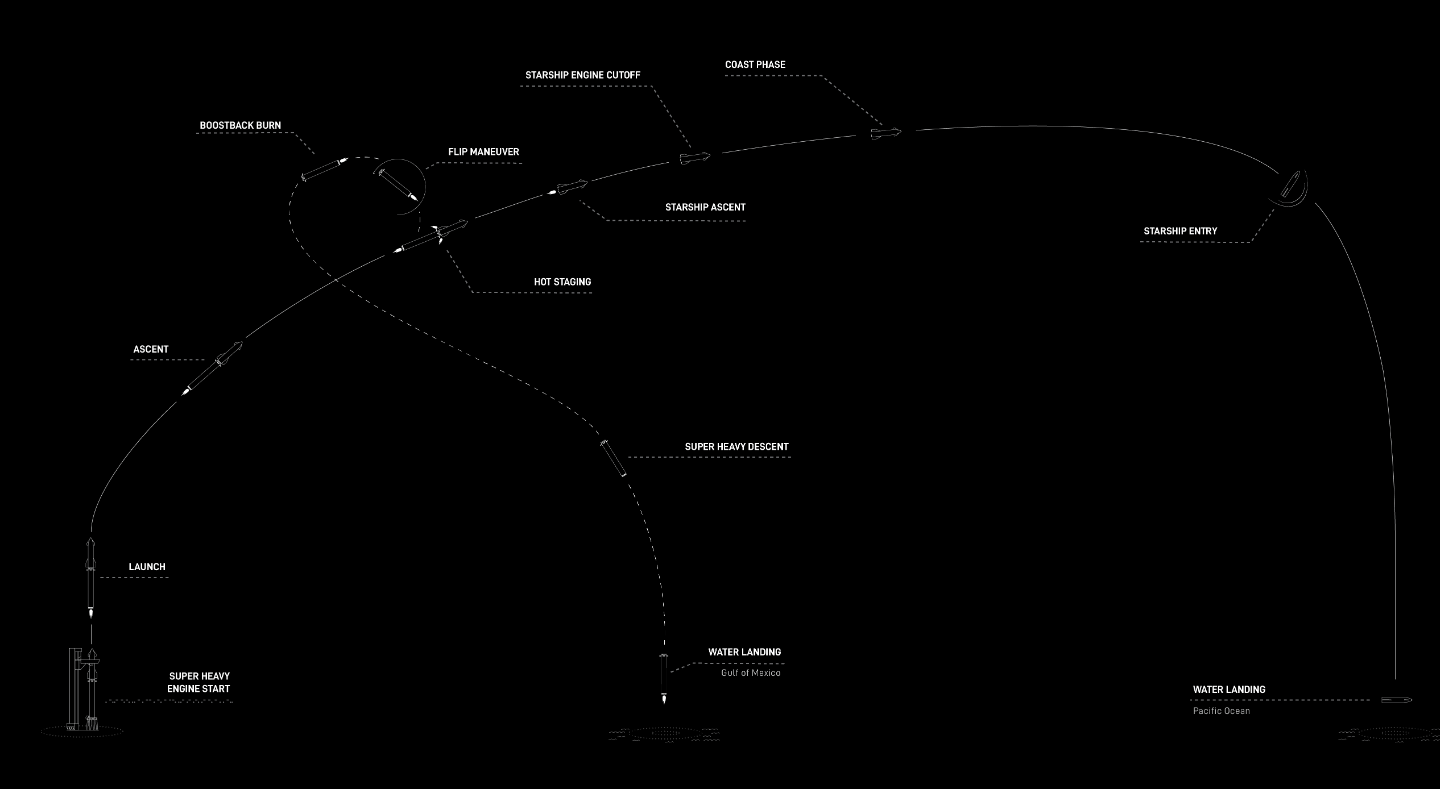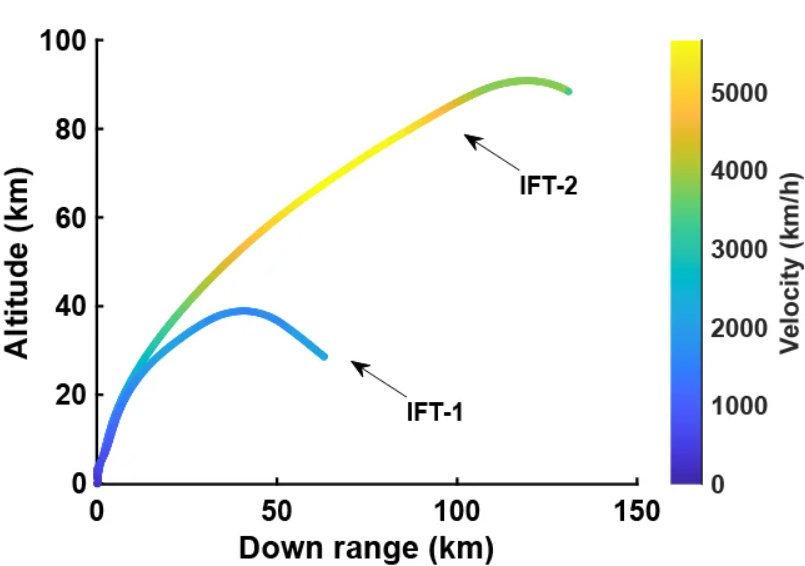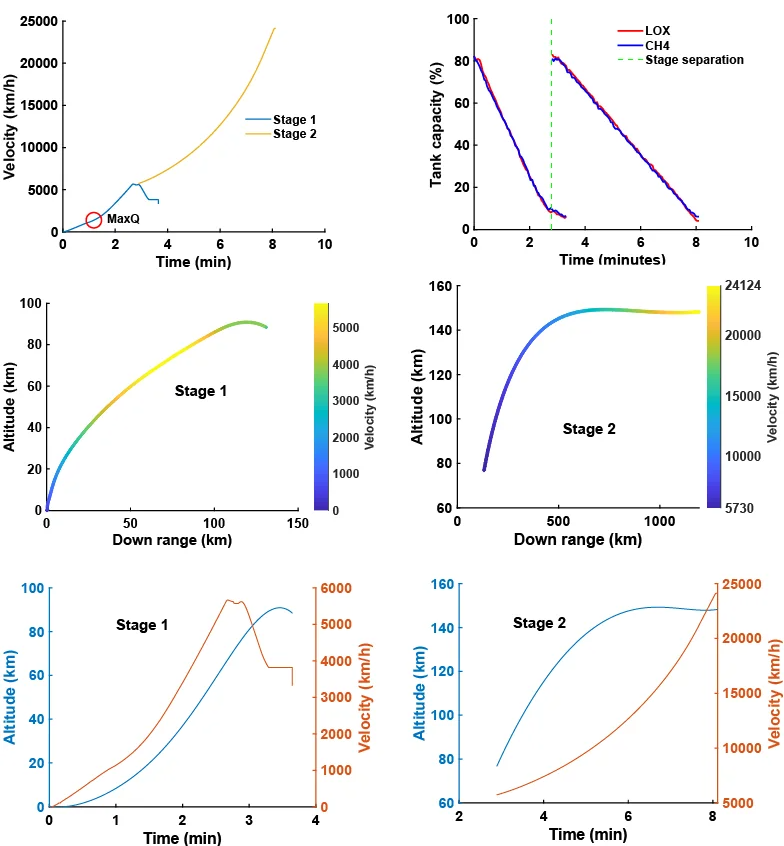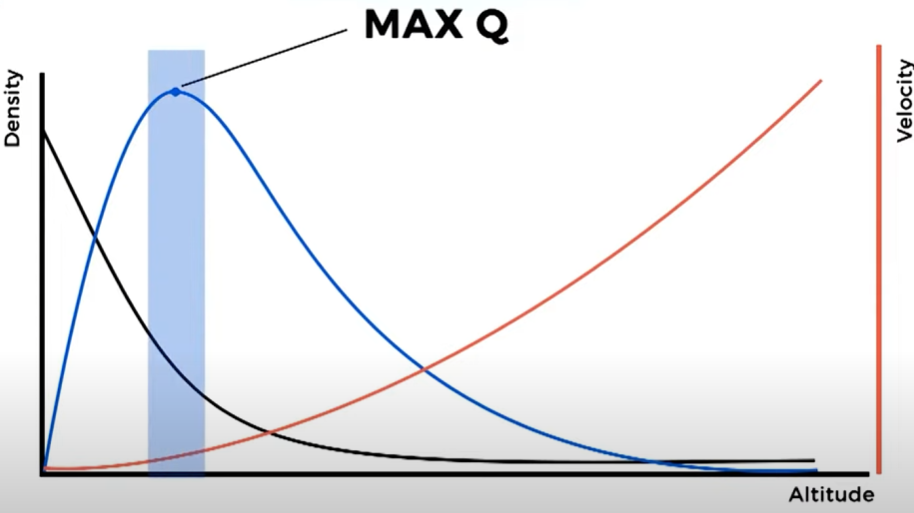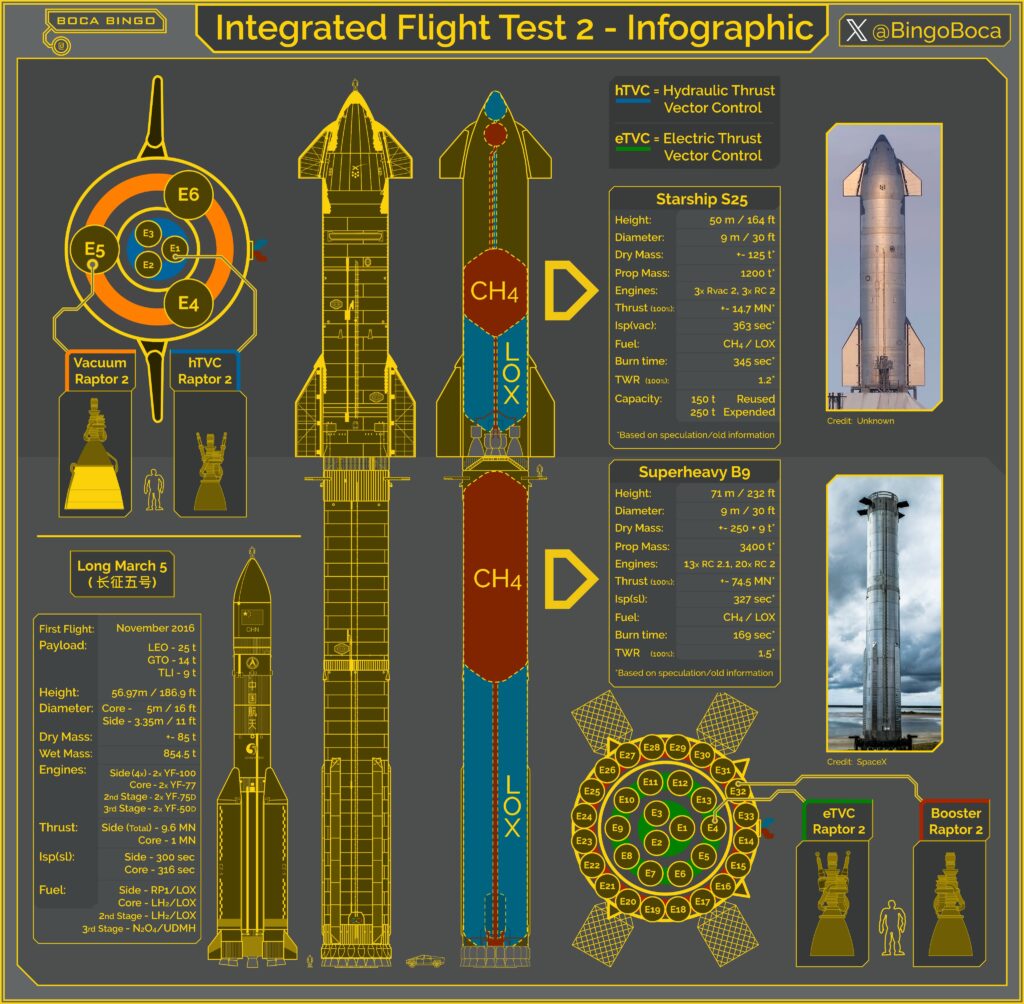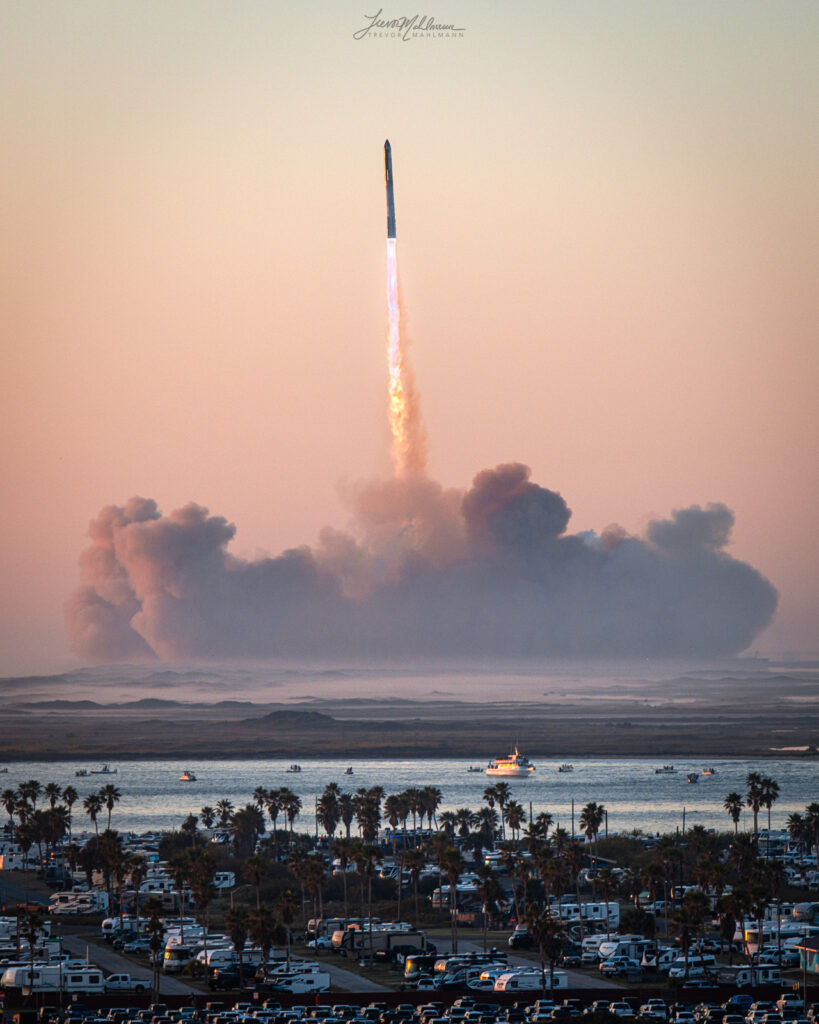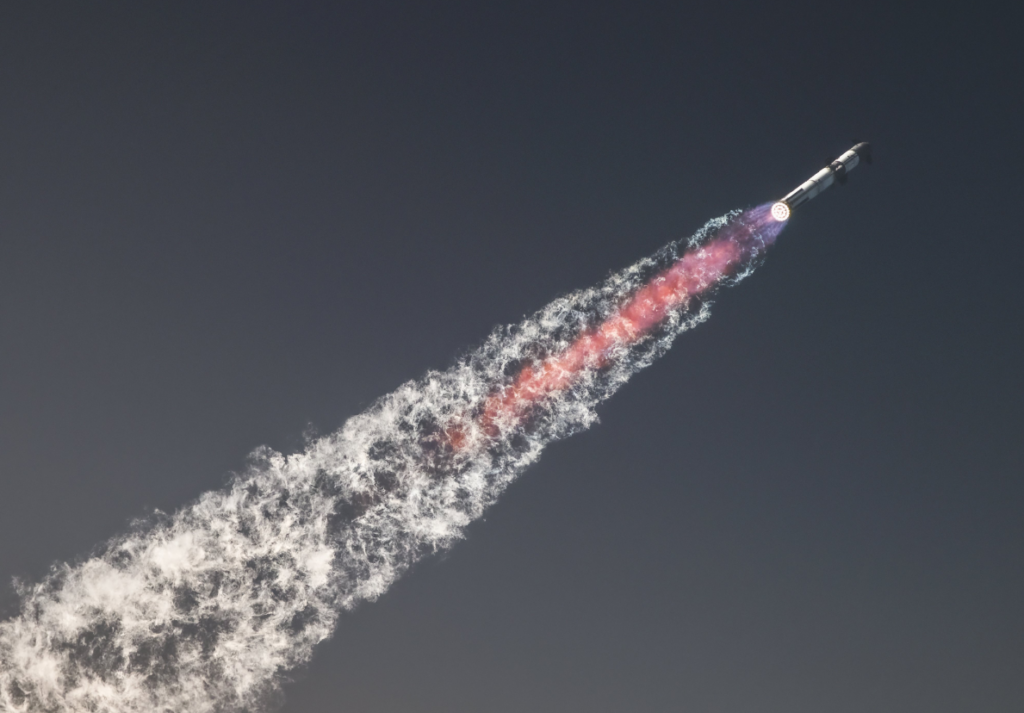SpaceX Starship I sequence of events (IFT-2)
SpaceX Starship II sequence of events (IFT-2)
Mission Flight test #II: B9/S25 (IFT-2)
Mission
- The second flight test of a fully integrated Starship will debut a hot-stage separation system and a new electronic Thrust Vector Control (TVC) system for Super Heavy Raptor engines, in addition to reinforcements to the pad foundation and a water-cooled steel flame deflector, among many other enhancements.
- Integrated Test Flight IFT-2 (OFT-2)
- Saturday 18-11-2023.
Flight objectives
Ascent.
Survival of the launch pad.
Separation of Starship (hot staging).
Test vacuum-optimized Raptors in space.
Configuration
- Super Heavy SH9, Booster B9.
- Starship SN25, S25.
Launch location
- Starbase Boca Chica.
Landing locations
- Booster: Gulf of Mexico.
- Starship: Pacific Ocean.
Launch preparation (dd:mm:yy)
- 27-06-2023 Static Fire (SF) S25.
- 04-08-2023 Spin Prime Test (SPT) B9.
- 06-08-2023 Static Fire (SF) B9.
- 08-09-2023 FAA review previous launch.
- 22-10-2023 Wet Dress Rehearsal (WDR) with full-stack.
- 10-11-2023 Flight Termination System (FTS) installed (FTS), stage 0, B9.
- 10-11-2023 Flight Termination System (FTS) installed (FTS), stage 0, S25.
- 11-11-2023 B9 and S25 destacked.
- 14-11-2023 USA Flight restrictions issued.
- 14-11-2023 Mexico Flight restrictions issued.
- 14-11-2023 Marine hazard zone Gulf issued.
- 14-11-2023 Marine hazard zone Hawaii issued.
- 14-11-2023 Road closure notification issued.
- 15-11-2023 Vehicle stacked.
- 15-11-2023 Fish and Wildlife Service (FWS) review previous launch.
- 15-11-2023 FAA Launch license issued/granted.
- 16-11-2023 Testing fins. Grid fin actuator must be replaced. Grid fins are the waffre-iron-like structures on the booster, which help steer its way back to Earth.
- 16-11-2023 Launch option 1.
- 17-11-2023 Launch option 1 scrubbed. De-stack and repair.
- 17-11-2023 Hot staging ring reinstalled after workers replaced three grid fin actuators.
- 18-11-2023 Launch option 2.
NOTAM (FAA Notice To Air Men) and TFR (FAA Temporary Flight Restrictions)
- 14-11-2023 Issued for Mexican airspace.
- 14-11-2023 Issued for Hawaii airspace.
- 15-11-2023 Issued by Brownsville airspace.
Option 1: Launch window IFT-2 Boca Chica Friday 17-11-2023 duration 02:00 (hh:mm) SCRUBBED
16-11-2023 Testing fins. Grid fin actuator must be replaced. 17-11-2023 Launch scrubbed
| Timezone | Preparations (2 hours to Open) | Coverage (30 mins to Open) | Window Open | Window Closed |
|---|---|---|---|---|
| CST (local) | 0500 am | 0630 am | 0700 am | 0900 am |
| EST | 0600 am | 0730 am | 0800 am | 1000 am |
| UTC/GMT | 1100 | 1230 | 1300 | 1500 |
| CET | 1200 | 1330 | 1400 | 1600 |
Option 2: Launch window IFT-2 Boca Chica Saturday 18-11-2023 duration 00:20 (hh:mm). Successful.
| Timezone | Preparations Go for propellant load | Coverage (30 mins to Open) | Window Open | Window Closed |
|---|---|---|---|---|
| CST (local) | 0500 am | 0630 am | 0700 am | 0720 am |
| EST | 0600 am | 0730 am | 0800 am | 0820 am |
| UTC/GMT | 1100 | 1230 | 1300 | 1320 |
| CET | 1200 | 1330 | 1400 | 1420 |
Clock
- Timezones:
Last seven hours before liftoff (T-time, hh:mm:ss)
- 07:00:00 Road closure window opens
- 05:00:00 Tank farm chilldown. Pope stick vent.
- 04:00:00 Chopsticks opened.
- 03:00:00 Pad clear.
- 02:20:00 OLM vent starts.
- 02:10:00 First tower vent.
- 02:00:00 Weather Go.
- 02:00:00 Range Go.
- 02:00:00 Vehicle Go.
- 02:00:00 Payload Go.
- 02:00:00 SpaceX Flight Director conducts poll and verifies: GO for propellant load
- 01:34:00 Stop OLM vent.
- 01:34:00 Booster LOX load underway. Frost ring.
- 01:34:00 Booster Methane load underway.
- 01:17:00 Ship Methane load underway.
- 01:13:00 Ship LOX load underway.
- 00:57:00 Release clamps open.
- 00:30:00 Coverage by SpaceX 30 minutes before liftoff starts (new tab).
- 00:19:42 Raptor begins engine chill on booster and ship.
- 00:05:00 Propellant load wraps.
- 00:01:33 Test move center engines Booster.
- 00:01:15 Checks completed.
- 00:00:40 Optional hold point (recycle). Needed for late pressurisation. Stay within launch window.
- 00:00:40 SpaceX Flight Director: GO for launch.
- 00:00:40 Release of the clock.
- 00:00:03 FireX activated.
- 00:00:10 Flame deflector activation (deluge).
- 00:00:03 Raptor ignition sequence starts.
Scheduled and actual events during flight (MET, hh:mm:ss)
| Phase | Scheduled | Actual | Booster | Starship | Altitude km | Speed km/h | Remarks |
|---|---|---|---|---|---|---|---|
| Launch | 00:00:02 | 00:00:05 | Liftoff | Liftoff | 0 | 126 | A. Booster: 33 engines Shockwave 00:00:10 cleared the tower. |
| Ascent | 00:00:52 | 00:01:08 | MaxQ | MaxQ | 11 | 1314 | B. Booster: 33 engines. |
| MECO | 00:02:39 | 00:02:41 | MECO | – | 68 | 5657 | C. Booster: 3 engines on 50%. To experience positive G’s and keep the fuel at the bottom of the tanks. Velocity decreases. |
| Hot staging (Starship activation) | 00:02:41 | 00:02:48 | – | Ignition (00:02:48) separation (00:02:51) All raptors (00:02:53) | Starship: 77 | Starship: 5737 | D. Ship: 3 Vacuum engines start. While still attached. To push the vehicles apart.
|
| Booster flip | 00:02:53 | 00:02:53 | Re-orientation | – | E. Booster flipover and relight inner engines to perform a boost back. | ||
| Booster back | 00:02:53 | Startup | – | 90 (RUD) | 3818 (RUD) | A number of the Raptors dit not relight Plumes/Flashes: 00:03:15 00:03:18 00:03:20 00:03:21 Booster RUD | |
| Boostback | 00:03:47 | Shutdown | – | ||||
| Booster descent | 00:06:18 | Transsonic | – | ||||
| Booster descent | 00:06:30 | Startup | – | ||||
| Booster landing | 00:06:48 | Burn / landing | – | Gulf of Mexico. No recovery. | |||
| Starship ascent | 00:08:04 (RUD) | 00:03:30 00:04:00 00:04:30 00:05:00 00:05:30 00:06:00 00:06:30 00:07:00 00:07:30 00:08:00 00:08:04 (RUD) | – | 90 116 128 137 144 148 149 149 148 148 148 (RUD) | 3818 7414 8419 9629 11031 12702 14678 17051 20016 23651 24114 (RUD) | 6 Raptors running (3 Sea level and 3 Vacuum) 00:07:07 Stable plume | |
| Starship engine cutoff (SECO) | 00:08:33 | – | Cutoff | ||||
| Starship coastal | – | Coastal | Semi orbital trajectory, perigee (lowest point) within the atmosphere (150-250 km). | ||||
| Starship entry | 01:17:21 | – | Start entry | No deorbit burn needed | |||
| Starship entry | 01:28:43 | – | Transonic | This mission no attempt to reignite the engines . | |||
| Starship landing | 01:30:00 | – | Plunge | Pacific Ocean near Island of Kauai. | |||
| x |
Evaluation IFT-2
Positive
- Launch pad survived (deluge).
- All 33 Booster Raptors active (performance?)
- Separation of Starship executed (hot staging).
- First performance of a vacuum-optimized Raptors in space.
Negative
- Booster
-
-
- Issue with the Quick Disconnect (QD).
- Propellant plumes.
- Partial boostback.
- Propellant issues:
-
- Issue with the propellant feeding the engines during the shutdown and relight sequence.
- It might be a problem with the propellant (not) feeding the engines. Fluid hammer or fuel slush (or a combination of both).
-
Booster maneuvers can cause the fluid to SLO around in the tanks and uncover the ports that are feeding the engines. If gas gets into the fuel lines feeding the pumps it can destroy the engines. Fluid hammer is an issue with a big rocket because we have many engines moving tons of propellant through the system. When you shut the engines down all that propellant has momentum that can hit hard on the valves and can damage the pipes. That’s why they shut down the engines om blocks of five at a time. Rather than shutting them down all at once.
-
- FTS activated (manual?).
- RUD.
-
-
- Starship
-
-
- Heat sheet tyles Starship fell off shortly after liftoff.
-
- Problems with the bonding process of glue on the metal seams.
-
- Velocity under-performance?
- Low on LOX? Structural issue in the feed lines?
- FTS activated.
-
- FTS triggered automatically because Starship went too far off course.
-
- RUD.
-
- The front part (with the wings) continues to fly after the RUD. As a result, the destruction was unsuccessful and an FAA investigation is underway.
- Starship debris reported in Puerto Rico.
-
- Heat sheet tyles Starship fell off shortly after liftoff.
-
-
IFT-2 Trajectory planned
IFT-1 and IFT-2 Telemetry Actual
IFT-2 Design
IFT-2 Liftoff impression
Starship
SpaceX, founded in 2002 by Elon Musk, has revolutionized the space industry through its innovative reusable rockets and ambitious goals for space exploration. One of the company’s most notable achievements is the Starship launch system, which has seen several successful launches and tests since its inception.
The first successful Starship prototype, SN5, took flight in August 2020, reaching a height of 500 feet before landing back on the launchpad. This was followed by the successful high-altitude flight of SN6 in September 2020, which reached an altitude of 7.8 kilometers before landing. The Starship program continued to make progress, with the successful flight and landing of SN8 in December 2020, reaching a height of 12.5 kilometers and landing in a controlled manner.
However, not all launches have been successful. SN9 exploded upon landing in February 2021, but this did not deter SpaceX’s efforts, as they continued testing with SN10 and SN11, both of which successfully landed. The company then had a string of successful launches, including the first operational flight of starship to orbit in May 2022, and the first successful crewed flight of the spacecraft in November 2022.
SpaceX’s starship launch system has garnered much attention for its reusable design, which is a major step forward in reducing the cost of space launches. The ability to reuse the starship makes space launches more affordable and accessible, which could greatly benefit both commercial and government space programs.
In addition to its cost-saving capabilities, the starship launch system has also been designed with interplanetary travel in mind. SpaceX aims to use the starship to eventually transport humans to Mars and establish a permanent settlement there. The company’s ultimate goal is to make life multi-planetary, and the starship launch system is a crucial component of this vision.
Overall, the history of SpaceX’s starship launches has been marked by significant milestones and breakthroughs in reusable rocket technology. The company’s commitment to innovation and ambitious goals has set it apart from its competitors and positioned it as a leader in the space industry. With continued development and successful launches, the future of space travel looks bright for SpaceX and its starship launch system.
Footnote
- Sources: Aerospace dashboard, SpaceX Starship progress, funkystuff.org
- Outgoing: SpaceX
- Keywords: SpaceX Starship progress, SpaceX sequence, NET is Not Earlier Than, called OFT-2 by FAA, IFT2, hTVC = Hydraulic Thrust Control, eTVC = Electric Thrust Controlm, SLO = Service Level Objective, SpaceX Starship II sequence of events. IFT-2, test 2, TF2, SpaceX 2, SpaceX II, SpaceX-2, SpaceX2, OTF2, OTF-2.

